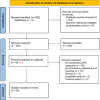STROBE-GEMA: a STROBE extension for reporting of geographically explicit ecological momentary assessment studies
- PMID: 38867286
- PMCID: PMC11170886
- DOI: 10.1186/s13690-024-01310-8
STROBE-GEMA: a STROBE extension for reporting of geographically explicit ecological momentary assessment studies
Abstract
Context: While a growing body of research has been demonstrating how exposure to social and built environments relate to various health outcomes, specific pathways generally remain poorly understood. But recent technological advancements have enabled new study designs through continuous monitoring using mobile sensors and repeated questionnaires. Such geographically explicit momentary assessments (GEMA) make it possible to link momentary subjective states, behaviors, and physiological parameters to momentary environmental conditions, and can help uncover the pathways linking place to health. Despite its potential, there is currently no review of GEMA studies detailing how location data is used to measure environmental exposure, and how this in turn is linked to momentary outcomes of interest. Moreover, a lack of standard reporting of such studies hampers comparability and reproducibility.
Aims: The objectives of this research were twofold: 1) conduct a systematic review of GEMA studies that link momentary measurement with environmental data obtained from geolocation data, and 2) develop a STROBE extension guideline for GEMA studies.
Method: The review followed the Preferred Reporting Items for Systematic Reviews and Meta-Analyses (PRISMA) guidelines. Inclusion criteria consisted of a combination of repeated momentary measurements of a health state or behavior with GPS coordinate collection, and use of these location data to derive momentary environmental exposures. To develop the guideline, the variables extracted for the systematic review were compared to elements of the STROBE (Strengthening the Reporting of Observational Studies in Epidemiology) and CREMAS (CRedibility of Evidence from Multiple Analyses of the Same data) checklists, to provide a new guideline for GEMA studies. An international panel of experts participated in a consultation procedure to collectively develop the proposed checklist items. RESULTS AND DEVELOPED TOOLS: A total of 20 original GEMA studies were included in the review. Overall, several key pieces of information regarding the GEMA methods were either missing or reported heterogeneously. Our guideline provides a total of 27 categories (plus 4 subcategories), combining a total of 70 items. The 22 categories and 32 items from the original STROBE guideline have been integrated in our GEMA guideline. Eight categories and 6 items from the CREMAS guideline have been included to our guideline. We created one new category (namely "Consent") and added 32 new items specific to GEMA studies.
Conclusions and recommendations: This study offers a systematic review and a STROBE extension guideline for the reporting of GEMA studies. The latter will serve to standardize the reporting of GEMA studies, as well as facilitate the interpretation of results and their generalizability. In short, this work will help researchers and public health professionals to make the most of this method to advance our understanding of how environments influence health.
Keywords: Environmental exposure; GPS; Geographically explicit momentary assessment; Guideline; Health; Review.
© 2024. The Author(s).
Conflict of interest statement
The authors declare no competing interests.
Similar articles
-
Geographically-explicit Ecological Momentary Assessment (GEMA) Architecture and Components: Lessons Learned from PMOMS.Inform Health Soc Care. 2021 Jun 2;46(2):158-177. doi: 10.1080/17538157.2021.1877140. Epub 2021 Feb 20. Inform Health Soc Care. 2021. PMID: 33612061 Free PMC article.
-
A geographically explicit ecological momentary assessment (GEMA) mixed method for understanding substance use.Soc Sci Med. 2018 Apr;202:89-98. doi: 10.1016/j.socscimed.2018.02.014. Epub 2018 Feb 16. Soc Sci Med. 2018. PMID: 29518701 Free PMC article.
-
The future of Cochrane Neonatal.Early Hum Dev. 2020 Nov;150:105191. doi: 10.1016/j.earlhumdev.2020.105191. Epub 2020 Sep 12. Early Hum Dev. 2020. PMID: 33036834
-
Spatio-temporal determinants of mental health and well-being: advances in geographically-explicit ecological momentary assessment (GEMA).Soc Psychiatry Psychiatr Epidemiol. 2016 Sep;51(9):1211-23. doi: 10.1007/s00127-016-1277-5. Epub 2016 Aug 24. Soc Psychiatry Psychiatr Epidemiol. 2016. PMID: 27558710 Free PMC article. Review.
-
Strengthening the Reporting of Observational Studies in Epidemiology Using Mendelian Randomization: The STROBE-MR Statement.JAMA. 2021 Oct 26;326(16):1614-1621. doi: 10.1001/jama.2021.18236. JAMA. 2021. PMID: 34698778 Review.
Cited by
-
Daily mobility, activity and environmental determinants of stress in ecological momentary assessment (EMA) and GPS studies: a scoping review protocol.BMJ Open. 2025 Jun 27;15(6):e091509. doi: 10.1136/bmjopen-2024-091509. BMJ Open. 2025. PMID: 40578867 Free PMC article.
References
-
- Chaix B, Méline J, Duncan S, Jardinier L, Perchoux C, Vallée J, et al. Neighborhood environments, mobility, and health: Towards a new generation of studies in environmental health research. Revue d’Épidémiologie et de Santé Publique. 2013;61:S139–45. - PubMed
Publication types
LinkOut - more resources
Full Text Sources


